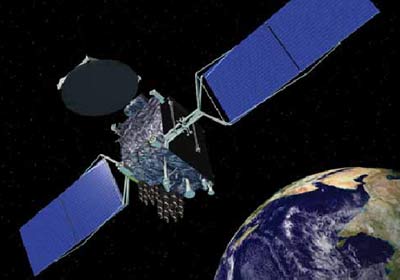Short recap: The ground station lost control of the geostationary (always over the same part of the Earth) communications satellite Galaxy 15, which has now started to drift from its position while still broadcasting. Folks are worried because it's still transmitting, so it might cause signal interference with other statellite broadcasts. They need to regain control and force a full shutdown.
I love the headlines for poor Galaxy 15. Do you prefer "Galaxy 15 Commercial Customers To Transition to Galaxy 12 Following Anomaly" (SpaceDaily) or the more lurid "Wayward 'zombiesat' poses risk to other satellites' (the Register)? Oh, and 'zombiesat' is a technical term. I love my job.
 |  |
| Galaxy 15 satellite, not to be confused with... | Guardians of the Galaxy issue 15 |
Anyway, my Project Calliope satellite will stay in its orbital groove. It is going to be a well behaved satellite. It won't threaten other satellites, and it promises to clean up after itself and not leave any space junk around to mess up other satellites.
In fact, for just $9.99, you can buy my book 'How to Train Your Satellite' and learn the secrets of how you, too, can have a well-behaved satellite of your own! (Offer not available in stores, act now!)
It's about energy. When you launch, you put some kinetic energy into those pups so they can break free of gravity a bit. You push them into a higher orbit. And you want a roughly circular orbit for long life. And your orbit, unless you have some strange boost, won't go much higher than your launch vehicle.
You typically want a circular orbit because then your satellite won't dip down into the atmosphere, which increases atmospheric drag, slows it down, and shortens its lifetime. Near circular are more stable, predictable orbits.
If you have a bad launch, typically your orbit goes elliptical, which means more egg-shaped, which means it dips into the atmosphere, slows down, reenters, and burns up. I've been on a mission where that happened. It was very disappointing and I don't recommend it.
There are predictable highly elliptical orbits, too, but they tend to take that shape because there's a scientific need, not for fun.
Your satellite deployment from its launching rocket is based on the fact that you deploy the satellite when your rocket is at the highest point it will reach, so generally, your satellite is at or near its apogee at launch. Part of this is because, again, you typically want a circular orbit. Unless you're shooting or boosting it with something else, your satellite is stuck in the groove you launch at.
One 'advantage' of our short duration low earth polar orbit is we can't threaten other satellites. TubeSats are eco-friendly in that they are designed to reenter and burn up completely within 3 months. Worst case of a bad launch means our satellites have a shorter lifetime in a lower, quicker-decaying orbit. There's not a chance they'll hop up higher and begin mugging other satellites.
So for the record, our satellite is going to be safe, well trained, and well behaved. And if for some reason it fails to follow those rules, it's die early. Nothing to fear.
Or is there?
Alex
Track The Satellite Diaries via RSS feed and Twitter @skyday (or go slumming in my main column, the Daytime Astronomer)



Comments